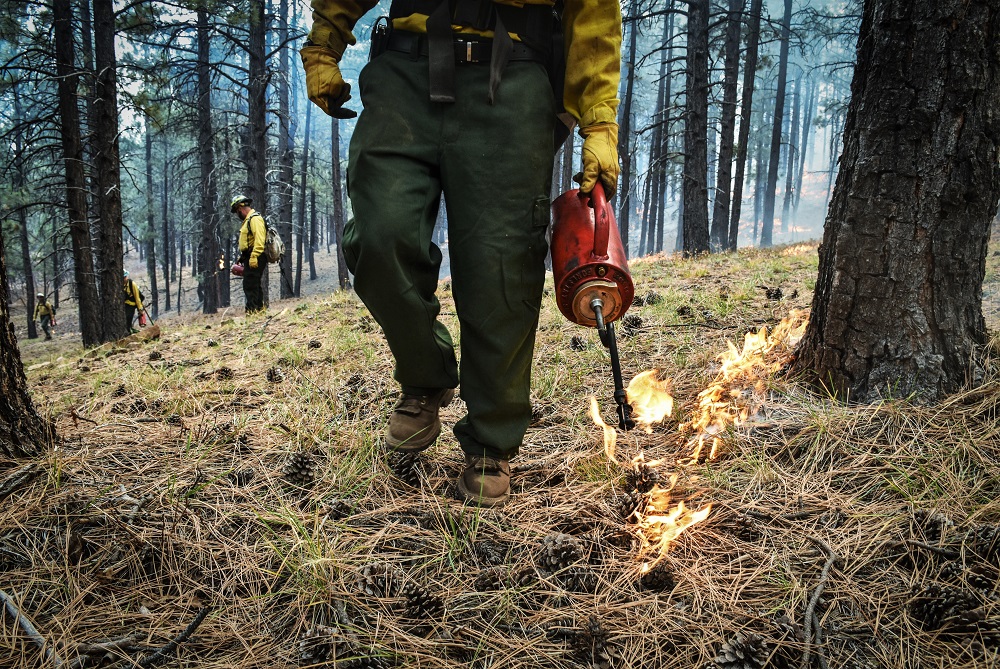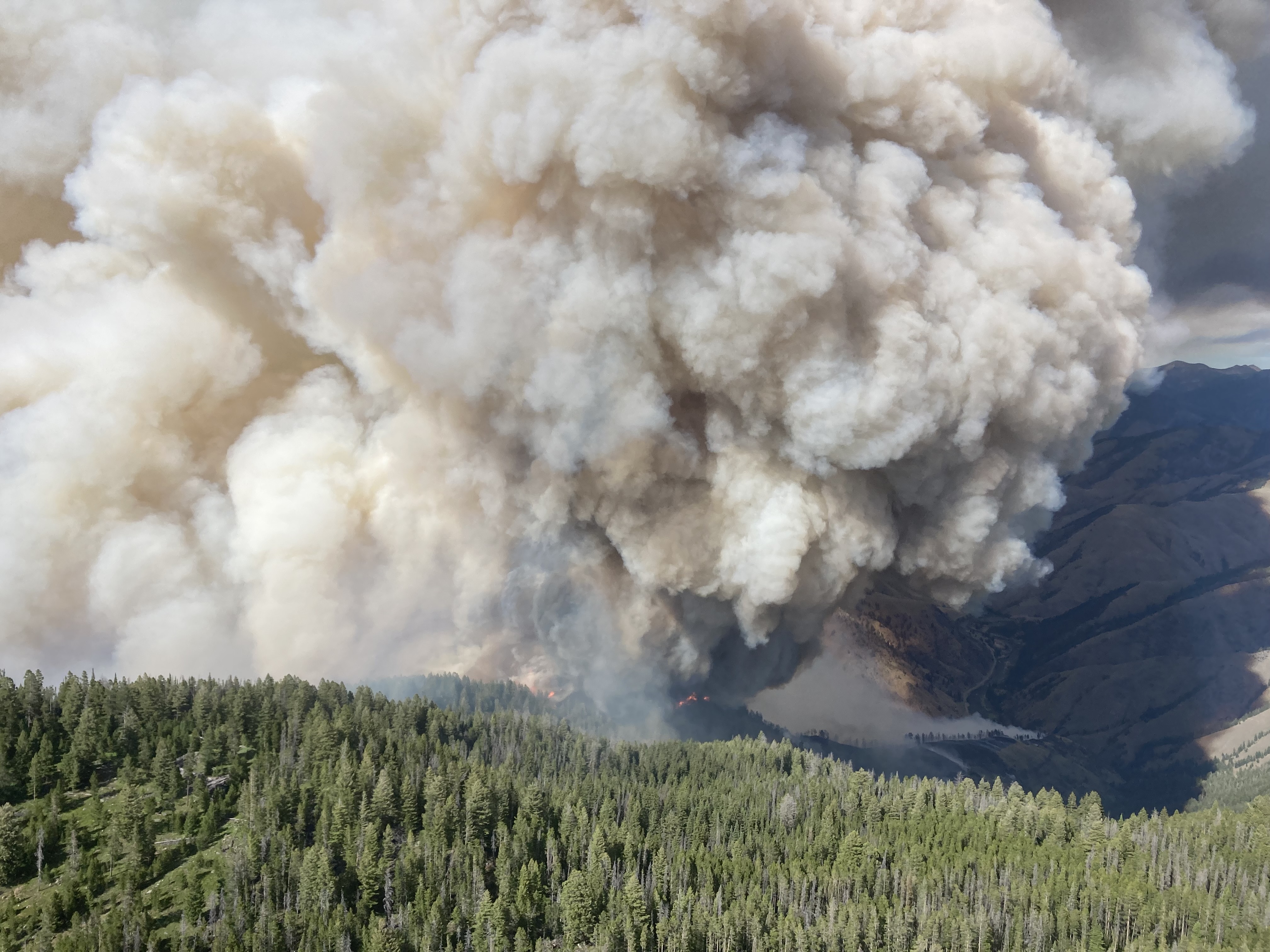Fire Management
When fires start on the Salmon-Challis National Forest, the Forest notifies the public via the Salmon-Challis National Forest Facebook and Salmon-Challis National Forest Twitter accounts as soon as information is available. If an Incident Management Team (IMT) is managing the fire, updates are not posted on this page.
Inciweb is great tool for researching large current incidents. Inciweb is an interagency all-risk incident information management system. Incidents on InciWeb are typically wildland fires, but the site will also host incidents when responding to natural disaster cleanup, search and rescue/recovery efforts, hurricane/tornado recovery or assisting other countries with manmade or natural disasters. This site serves as a single source of incident related information and is managed by Incident Management Teams or local public information officers.
Additional incident specific information may also be accessed at InciWeb.
2024 Fire Information
Useful Links
WOODTICK FIRE EMERGENCY AREA, ROAD, AND TRAIL CLOSURE JULY 27, 2022
EXPANDED MOOSE FIRE EMERGENCY AREA, ROAD, AND TRAIL CLOSURE JULY 26, 2022
MOOSE FIRE EMERGENCY AREA, ROAD, AND TRAIL CLOSURE JULY 22, 2022
MOOSE FIRE UPDATE JULY 19, 2022
MOOSE FIRE UPDATE JULY 18, 2022
MOOSE FIRE EMERGENCY AREA, ROAD, AND TRAIL CLOSURE JULY 18, 2022
Maps
2023 FIRE INFORMATION -
FIRE SUMMARY SEPTEMBER 25, 2023
FIRE SUMMARY SEPTEMBER 5, 2023
HAYDEN FIRE CLOSURE TERMINATED
CHILCOOT FIRE FACT SHEET AUGUST 18, 2023
CHILCOOT FIRE FACT SHEET AUGUST 16, 2023
CHILCOOT FIRE FACT SHEET AUGUST 13, 2023
HAYDEN FIRE UPDATE JULY 20, 2023
HAYDEN FIRE UPDATE JULY 19, 2023
Moose Fire
Moose Fire: Living and Working in a Post-Wildfire Landscape
How one year later the Salmon-Challis National Forest and Partners work to adapt to an evolving post-fire landscape.
Impacting Recreation on the Salmon River
Managing wilfire in the fire-adapted, crown jewel of the Wild and Scenic River System, located in the heart of Idaho
Wrestling with the Moose Fire
How a large fire in Idaho is trying our patience, revealing a history of challenges, and teaching us to move forward together; Salmon-Challis National Forest; September 20, 2022
Click here for --> Burned-Area Report; Moose Fire 2022 and Owl Fire 2022; Salmon-Challis National Forest
Woodtick Fire
Woodtick Fire Response Strategies
Maximizing Protection of Values while Minimizing Risk to Resources~Salmon- Challis National Forest 2022
This Storymap tells the story of the evolution of firefighting strategies used on the Woodtick Fire to successfully defend the values at risk, including private property and infrastructure.
-
What is Prescribed Fire?

Learn more about planned, on-going and completed prescribed fire operations across the USDA Forest Service Intermountain Region.
Trail Creek Fire
Prepared for Fire - When Years of Collaboration Met the Trail Creek Fire
Approximately 15 years ago, the Salmon-Challis National Forest, in collaboration with local communities, residents, and key stakeholders began an all-lands effort to promote forest health and safer communities from wildfire in the North Fork and Gibbonsville of the Upper North Fork Salmon River valley of Idaho. A century of fire exclusion here has resulted in ecological conditions that threaten the resilience of plant and wildlife species and natural functions.
As early as 2006, the collaborative Lemhi Forest Restoration Group and the Salmon-Challis envisioned a suite of forest stewardship and management projects to allow fire to play a more natural role on the landscape where appropriate and create less hazardous fuel conditions within wildland-urban interface areas.
Fire doesn’t respect property boundaries, but cross-boundary cooperation by land and fire managers is the key to effective wildfire mitigation. The forest worked closely with local communities, residents, and key stakeholders to identify the right locations and tools for fuels and forest health treatments that are science-based and equitable. The map below shows where strategically placed fuels reduction treatments helped firefighters protect community assets when the Trail Creek Fire crossed the Continental Divide in August 2021.
The most common misconception of wildfire is that all fire is bad. But there are important benefits that smaller and more frequent fires offer to the environment. Matt Jolly, an ecologist at the U.S. Forest Service Rocky Mountain Research Station, talks about the natural and important role of fire in maintaining a healthy ecosystem.
Drones are dangerous if flown near wildfires. Drones can interfere with wildland fire air traffic that are necessary to suppress wildland fires. If drones are spotted near a wildfire, firefighting aircraft may have to land due to safety concerns.
Forest managers and wildland firefighters will often talk use the word “fuels.” What are fuels? It’s both the living and dead vegetation in a forest that can potentially burn in a wildfire. David Peterson, biologist for the U.S. Forest Service Pacific Northwest Research Station, explains how reducing fuels helps to reduce the intensity of wildfires.
Wildland Firefighters on Rappel capable crews, come from all over the nation each spring to train at the National Rappel Program’s Rappel Academy at Salmon AirBase, in Salmon, Idaho. Wildland fire aircraft play a critical role in supporting firefighters on wildland fires. Helicopters also deliver aerial crews called Rappellers to wildland fires.
These are specially trained firefighters that rappel from helicopters in order to effectively and quickly respond to fires in remote terrain. Rappellers may land near a wildfire but if there is no landing zone close by they can utilize their skills to rappel from the hoovering helicopter. Once on the ground, crews fight the fires using hand tools, chainsaws, and other firefighting tools. Filmed and edited by Charity Parks.
The majority of the wildland fires on the Salmon-Challis National Forest and the Salmon and Challis Field Offices of the Bureau of Land Management are caused by lightning. We would like to keep it that way!

2022 Moose Fire on the Salmon-Challis National Forest
Photo July 17, 2022
2011 Salt Fire Footage
Features
1985 Butte Fire Staff Ride

It is the afternoon of Aug. 29, 1985. You are on Division A located in heavy timber on the north end of the Butte Fire on the Salmon National Forest in central Idaho. This fire is part of the Long Tom Complex.
At approximately 1550, the fire makes a sudden high-intensity crown run up Wallace Creek, a side drainage of Salmon River Canyon. Over the next 90 minutes, this run will consume 3,500 acres.

